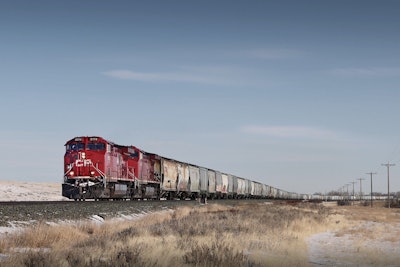
The recent U.S. Department of Agriculture (USDA), Agricultural Marketing Service (AMS) Grain Transportation Report broke down this year in grain transportation, here are some of the highlights. In 2023, the grain transportation industry faced numerous challenges that impacted the movement of grain both domestically and internationally. From a decline in grain inspections for export to barge shipment obstacles and volatile ocean freight rates, the year presented a series of hurdles for the industry to overcome.
Year-to-year grain inspections
One notable trend in 2023 was the decrease in year-to-date (YTD) grain inspections for export compared to the previous year. Overall, YTD inspections fell from 129.9 million metric tons (mmt) in 2022 to around 105.5 mmt in 2023. Corn inspections experienced the most significant decline, down 24 percent, followed by soybeans (15 percent) and wheat (13 percent). The decline in corn inspections was primarily attributed to a substantial drop in inspections destined for China, which decreased by 64 percent from the previous year. Similarly, the decline in soybean inspections was mainly due to a decrease in inspections destined for several Asian countries. Additionally, lower inspections for wheat were primarily a result of reduced shipments to Latin America and Africa.
Barge shipments and obstacles
The barge industry faced its fair share of challenges in 2023, mirroring the difficulties observed in the previous year. In the spring, high water levels caused by snow melt in the upper Mississippi River led to the closure of locks north of St. Louis, MO. Subsequently, low water levels throughout the Mississippi River System (MRS) during the summer resulted in draft restrictions, tow restrictions, and travel delays. As a result, weekly grain volumes through the MRS lagged behind the previous year and the 5-year average for most of the year. The most significant declines in grain volumes occurred during the lock closures in the spring and the draft and tow restrictions in the summer. Surprisingly, despite these challenges, barge spot rates did not reach their 2022 levels. Notably, the spot rate at St. Louis, MO, remained relatively unaffected by the low-water conditions.
Rail service improvements amid low volume
The rail service challenges experienced in 2022 continued into early 2023 before improving in the spring. The number of unfilled orders for empty grain cars in manifest service reached its peak in January 2023 before declining to under 1,000 in May. The improvements in rail service can be partly attributed to below-average carloads, as annual grain rail carloads in 2023 were approximately 10 percent lower than in 2022. The overall rail traffic also decreased, mainly due to below-average rail movements of shipping containers. The rail industry witnessed significant developments in 2023, including the approval of the merger between Canadian Pacific Railway and Kansas City Southern Railway, paving the way for the creation of CPKC in April. Additionally, proposed rules for reciprocal switching for inadequate service were issued by the Surface Transportation Board (STB) in September, following over a decade of consideration. Furthermore, the temporary closure of two major rail crossings on the U.S.-Mexico border disrupted exports to Mexico, emphasizing the importance of transportation in the global supply chain.
Volatile ocean freight rates
Ocean freight rates experienced volatility throughout 2023, influenced by various factors. After falling in the first quarter due to lower seasonal demand, rates slightly rose in the second quarter, dropped again in the third quarter, and increased once more in the fourth quarter. Several factors contributed to these fluctuations, including extreme weather conditions, the end of the Black Sea Grain Initiative, weakened grain demand from China, increased vessel capacity, and restricted passage through the Panama Canal due to low water levels. As of the week ending December 14, the rate for shipping a metric ton of grain to Japan from the U.S. Gulf was $60.75, representing an increase from the same week in the previous year. On the other hand, the rate for shipping a metric ton of grain to Japan from the Pacific Northwest was $31.75, a decrease from the same week in the previous year. The number of grain vessels loaded in the U.S. Gulf also witnessed a decline in 2023 compared to 2022.
Fuel price fluctuations
Fuel prices experienced significant fluctuations in 2023, following record highs in the previous year. From February to June, the U.S. average diesel price continuously declined, dropping by a total of 82.8 cents per gallon. Subsequently, from July to October, the price rose by 73.9 cents per gallon due to a rise in global oil demand and multiple cuts in oil production. However, over the last eight weeks of the year, the average diesel price fell by 65.1 cents per gallon, reflecting declining crude oil prices in response to record-high U.S. and Brazilian oil production and softening demand from China. Despite this volatility, the average diesel price from January to November 2023 remained approximately 17 percent above the prior 3-year average. The U.S. Energy Information Administration's December Short-Term Energy Outlook projected a further drop in the retail diesel price for 2024, attributed to increased global oil production and slightly lower global oil consumption.

















